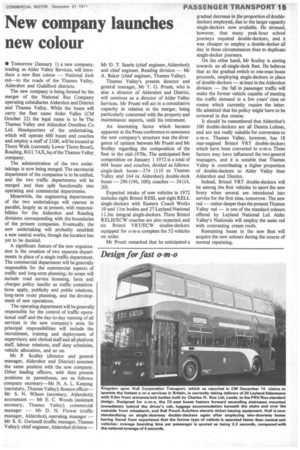New company launches new colour
Page 17

If you've noticed an error in this article please click here to report it so we can fix it.
• Tomorrow (January 1) a new company, trading as Alder Valley Services, will introduce a new fleet colour — National dark red—to the roads of the Thames Valley, Aldershot and Guildford districts.
The new company is being formed by the merger of the National Bus Company operating subsidiaries Aldershot and District and Thames Valley. While the buses will carry the fleet name Alder Valley (CM October 22) the legal name is to be The Thames Valley and Aldershot Omnibus Co Ltd. Headquarters of the undertaking, which will operate 600 buses and coaches and employ a staff of 2100, will be located at Thorn Walk (currently Lower Thorn Street), Reading, RG1 7AX, hq of the Thames Valley company.
The administration of the two undertakings is now being merged. The secretarial department of the companies is to be unified, and the two traffic departments will be merged and then split functionally into operating and commercial departments.
Meanwhile, the engineering departments of the two undertakings will operate in parallel, largely as at present, with responsibilities for the Aldershot and Reading divisions corresponding with the boundaries of the present companies. Eventually, the new undertaking will probably establish a new central works, though the location has yet to be decided.
A significant feature of the new organization is the creation of two separate departments in place of a single traffic department. The commercial department will be generally responsible for the commercial aspects of traffic and long-term planning; its scope will include road service licensing, fares and charges policy insofar as traffic considerations apply, publicity and public relations. long-term route planning, and the development of new operations.
The operating department will be generally responsible for the control of traffic operational staff and the day-to-day running of all services in the new company's area. Its principal responsibilities will include the recruitment, training and deployment of supervisory and clerical staff and all platform staff, labour relations, staff duty schedules, vehicle allocation, and so on.
Mr P. Sculley (director and general manager, Aldershot and District) assumes the same position with the new company. Other leading officers, with their present positions in parentheses, are as follows: company secretary—Mr N. A. L. Keeping (secretary, Thames Valley); finance officer— Mr S. N. Wilson (secretary, Aldershot); accountant — Mr E. C. Woods (assistant secretary, Thames Valley); commercial manager — Mr D. N. Flower (traffic manager, Aldershot); operating manager — Mr S. E. Gwinnell (traffic manager, Thames Valley); chief engineer, Aldershot division —
Mr D. T. Searle (chief engineer, Aldershot); and chief engineer, Reading division — Mr A. Baker (chief engineer, Thames Valley).
Thames Valley's present director and general manager, Mr T. G. Pruett, who is also a director of Aldershot and District, will continue as a director of Alder Valley Services. Mr Pruett will act in a consultative capacity in relation to the merger, being particularly concerned with the property and maintenance aspects, until his retirement.
An interesting factor which became apparent at the Press conference to announce the new company's structure was the divergence of opinion between Mr Pruett and Mr Sculley regarding the composition of the fleet in the mid-1970s. The anticipated fleet composition on January 1 1972 is a total of 604 buses and coaches, divided as follows: single-deck buses-274 (110 ex Thames Valley and 164 ex Aldershot); double-deck buses —296 (196, 100); coaches — 34(14, 20).
Expected intake of new vehicles in 1972 includes eight Bristol RESL and eight RELL single-deckers with Eastern Coach Works 10 and llm bodies and 27 Leyland National 11.3m integral single-deckers. Three Bristol RELH/ECW coaches are also expected, and six Bristol VRT/ECW double-deckers equipped for o-m-o complete the 52 vehicles on order.
Mr Pruett remarked that he anticipated a gradual decrease in the proportion of doubledeckers employed, due to the larger capacity single-deckers now available. He stressed, however, that many peak-hour school journeys required double-deckers, and it was cheaper to employ a double-decker all day in these circumstances than to duplicate single-decker journeys.
On the other hand, Mr Sculley is aiming towards an all-single-deck fleet. He believes that as the gradual switch to one-man buses proceeds, employing single-deckers in place of double-deckers — at least in the Aldershot division — the fall in passenger traffic will make the former vehicle capable of meeting the traffic demand in a few years' time on routes which currently require the latter. He admitted that his policy might have to be reviewed in due course.
It should be remembered that Aldershot's 100 double-deckers are all Dennis Lolines, and are not really suitable for conversion to o-m-o. Thames Valley, however, has 18 rear-engined Bristol VRT double-deckers which have been converted to o-m-o. These factors may have influenced the two general managers, and it is notable that Thames Valley is contributing a higher proportion of double-deckers to Alder Valley than Aldershot and District.
Indeed, Bristol VRT double-deckers will be among the first vehicles to sport the new livery when several are introduced into service for the first time, tomorrow. The new red — rather deeper than the present Thames Valley red — is one of the standard colours offered by Leyland National Ltd. Alder Valley's Nationals will employ the same red with contrasting cream roofs.
Remaining buses in the new fleet will acquire the new colours during the course of normal repainting.












































































